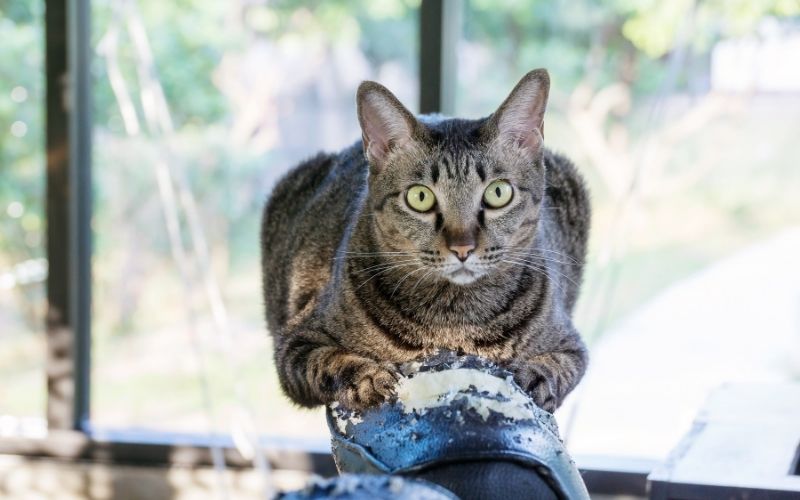Cat scratching is perfectly normal behavior for a cat. But what if you’ve got a new office chair and are worried about your cat ruining it?
We’ve researched the subject so you don’t have to! From furniture shields to training behaviors, we know what it takes to protect your cat and your furniture.
Here are a few tried and tested solutions to save your office chair from your cat’s claws.
- Use furniture shield
- Use cat scratch spray
- Use double-sided tape
- Reupholster the chair
- Trim their nails
- Put a blanket on the chair
- Use a scratching post
Let’s look at the solutions and more cat problems in detail below.
Table of Contents
Why Do Cats Love to Scratch Desk Chairs?
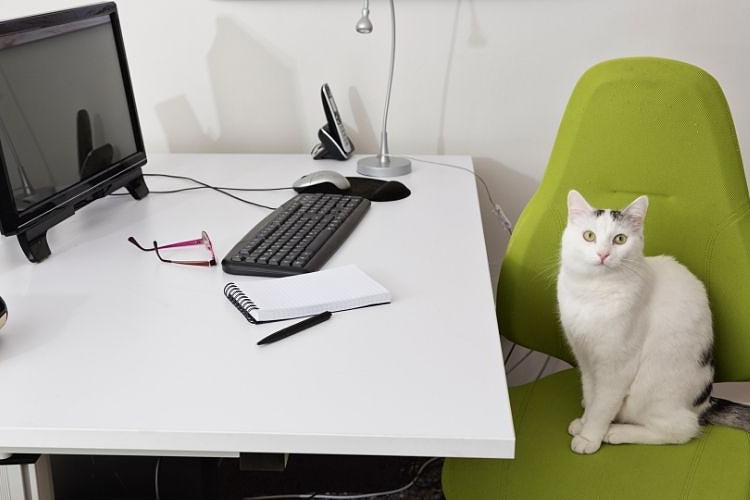
Cats love materials like mesh and foam. These are materials most commonly used on office chairs.
If your chair is made of materials like these, your cats will make it their favorite spot to claw.
If your cat has started to scratch the furniture out of the blue, it might be a behavioral or environmental issue.
How Do I Keep My Cat Off My Office Chair?
Use an Anti-Scratch Spray

An anti-scratch spray is a solution that is sprayed on furniture to deter cats from scratching it. Most sprays are safe for cats but will damage some types of furniture.
Check the solution to make sure you can spray it on the materials and fabrics in your house. An effective anti-scratch spray deters scratching behavior, is safe for your cat and your furniture as well.
However, we’ve found anti-scratch sprays to be ineffective on some cats. This could be because you aren’t spraying the solution as frequently.
Look at the product usage instructions and follow them correctly to make sure there are no loose ends.
Reupholster the Chair
Reupholstering your chair with a cat-repellent fabric is a great solution. It keeps your cat from scratching and also gives you the chance to redo your chair’s fabric.
Some cat-repellent fabrics include:
- Microfiber
- Velvet
- Velour
- Leather
- Denim
- Polyester
- Ultra suede
Use Double-Sided Tape

Put double-sided sticky tape on surfaces that you don’t want your cat to scratch. The stickiness becomes an irritant to the cat without harming it in any way.
Once you’re sure your cat is no longer interested in the chair, you can remove the tape.
You can also use temporary solutions like plastic sheets or aluminum foil to cover your chair as cats tend to avoid scratching them.
Use Furniture Shield

A furniture shield can act as a barrier between your cat’s claws and the upholstery. They are invisible to match with your upholstery and flexible to fit around corners as well.
Furniture shields are made of materials like marine-grade vinyl, are waterproof, and can be attached to any type of upholstery.
Use a Scratching Post

A scratching post is an alternative surface that your cat can scratch. The idea here is to give your cat enough scratching exercise so that it is disinterested in scratching any other surfaces.
Scratching posts come in various heights and materials. They let your cat stretch while looking after its claws. They are also attractive enough for them to prefer scratching the post instead of any furniture.
If your cat isn’t already trying out the scratching post, try spraying some catnip oil on the post.
Removable Seat Cushions
Get removable seat cushions that you can use when working at the desk and then store away safely.
Use a Pheromone Diffuser

Scratching can be a sign of nervousness and anxiety. The reasons can be hard to determine. It is more common in young cats that are introduced to new surroundings.
Use a pheromone diffuser to calm your cats for the first few weeks or months. You can also use this trick whenever you’re introducing your cat to a new house, furniture, or people.
Train Your Cat
This isn’t a quick fix, but a permanent solution to the problem. Slowly teach your cat acceptable and unacceptable behaviors.
Instead of confusing them with lists of objects, make scratching a complete no-no inside the house.
A great trick to stop unacceptable behavior is to startle your cat. Fill a tin can with coins and shake it whenever your cat scratches away at the furniture.
How to Protect My Office Chair From Cats?
Trim Your Cat’s Nails
Use a clipper/ grinder to trim your cat’s nails. Trimming makes their nails blunter and shorter.
Trimming your cat’s nails protects people, furniture, and fabrics from your cat’s claws. Schedule a trim once every two weeks.
Put a Blanket on the Chair
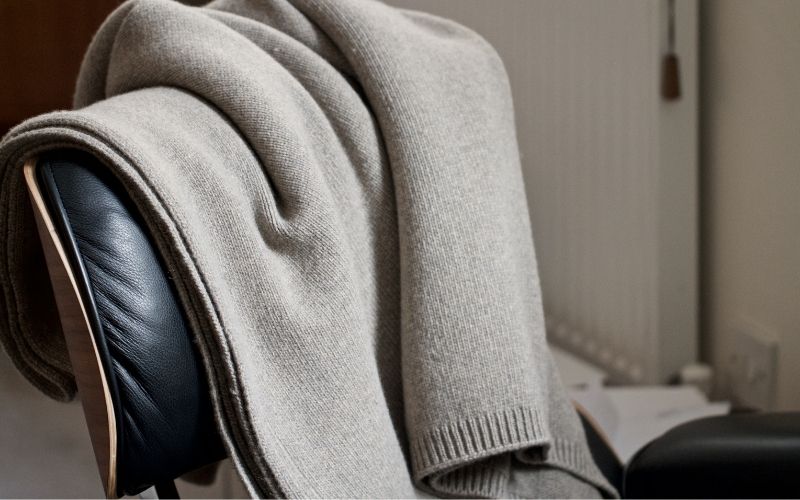
Similar to a furniture shield, a blanket can also deter your cat from scratching your chair. The reason is that blankets aren’t an ideal surface for cats to scratch.
Use a blanket to cover your chair when not in use. While cheap and easy, a blanket is only a temporary solution which the cat can easily remove.
Silicone Nail Caps

Silicone nail caps can be placed onto your cat’s claws to dull their sharpness. These caps don’t harm the cat in any way and they aren’t painful either.
With silicone nail caps on, you can rest assured your cat won’t be damaging the upholstery of furniture even after scratching.
Initially, the cat might be uncomfortable and try to take the caps off, so you need to keep putting them on. Once they’re used to it, you won’t have to do this regularly.
How Do I Fix Cat Scratches on My Office Chair?
Your cat has stopped scratching, but how do you repair damage already done? Well, we’ve got a few solutions.
Make sure to use a white cloth to clean the surface as the dye can seep into the office chair seat from the cloth.
Leather
- Clean the area with a household cleaner or white vinegar
- Trim or remove any loose fibers
- Use a binder to strengthen the weakened structure of the leather
- Use a 1,200 grit sandpaper to sand the surface and make sure it is smooth
- Use a leather filler to fill in scratches or holes and sand the surface again
- Use a color adjusting kit for leather to perfectly blend with the rest of the office chair seat
Cloth
- Trim extra fibers from the surface
- Choose a fabric patch with similar color and pattern to cover the tear
- Sew the fabric or stick it onto the tear with some fabric glue
- Trim any leftover fabric from the edges
These methods can be good solutions to fix minor tears. However, we recommend calling a specialist to fix bigger scratches or holes in your upholstery. Once you’re sure your cat isn’t going to attack your chair anymore, call in a professional.
What Should You Avoid Doing?
Don’t Scream, Yell, or Spray Water on Them
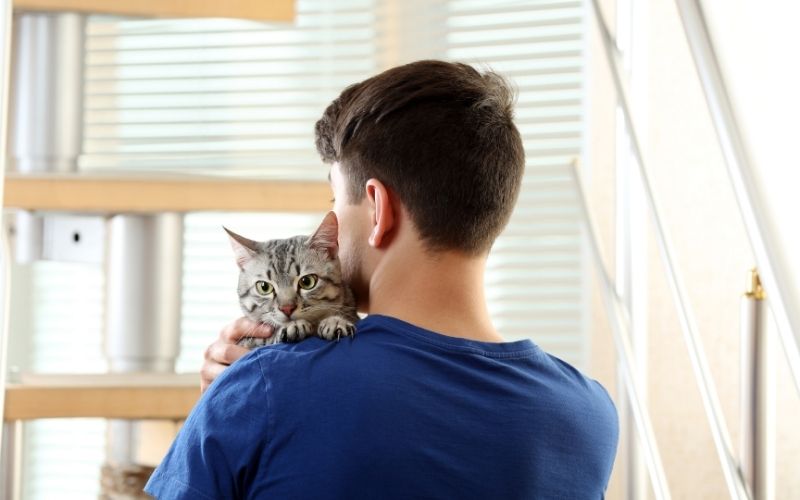
Cats don’t understand yelling or screaming and neither do they react well to negative reinforcement. It is more likely your car will start misbehaving once it finds you reacting this way.
Instead, use positive reinforcement or treats to reward them for good behavior. This reminds them to obey house rules and listen to your cues about acceptable and unacceptable behavior.
Don’t Declaw
Declawing is a painful and risky procedure. It hurts your cat, risks their health, and also mentally scars them.
Declawing might make your cat violent, distrustful, and less likely to use the litter box. Many studies also suggest that declawing causes long-term pain and limping in cats.
A few complications of declawing observed in cats are:
- Infection
- Pain in paw
- Lameness
- Back pain
- Tissue death
Conclusion
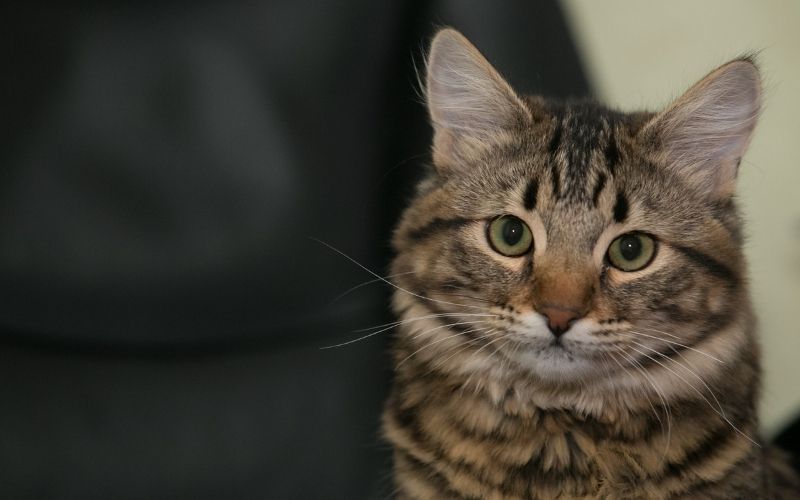
When it comes to preventing cats from scratching at your chair there are several solutions. Either find the root cause of the problem, shield your upholstery, or cover your cat’s nails.
If you’re successful in keeping the damage to a minimum using these methods, then go ahead and try to fix past damages.
We hope these solutions are useful to you!

My name is Vance, and I am the owner of To Ergonomics. Our mission is to improve your workflow by helping you create a supportive and welcoming environment. We hope that you’ll find what you’re looking for while you’re here.

